“It’s up to the commissioners in those (eligible) counties on if they want to do it or not,” Coley said. “Nothing’s mandatory. It’s all discretionary on their end whether they want to do it or not.”
TRANSPORTATION BILL: How much should Ohio raise the gas tax? Debate continued Friday
Coley called the amendment “a pilot program” as an alternative way to operate an Emergency Management Agency, and wanted to give Butler County a shot to test it out. And Coley said it frees up funds for local governments if they “get into a jam of funding their EMA obligations or funding extra firefighter or funding extra law enforcement.”
The amendment is designed for Butler and Stark counties to take advantage of the pilot program. The amendment allows a county between 350,000 and 400,000 in population to enter into a four-year contract with a county sheriff or countywide fire department. Butler is just one of two counties that meets the population requirement.
However, Butler County EMA Director Matt Haverkos said Stark County wouldn’t be eligible because it’s not formed under the same Ohio Revised Code statute as Butler County. There are two ways under the Ohio Revised Code to form a countywide emergency management agency.
In Butler County, each jurisdiction pays a $0.39 per-capita fee, but some counties, such as Warren County, operate under the county commission under another state statute. Coley’s amendment would provide a third option that “would put the commissioners on the hook for fronting the EMA,” Haverkos said.
MORE: Jones: Combining sheriff’s office, disaster agency would save taxpayers (October 2016)
The Butler County EMA administers a number of emergency management teams, including for hazardous materials team, search and rescue, and incident management. The agency also administers regional public safety equipment and technology in every member jurisdiction.
“All of our funds have specific requirements for how it can be used and is approved annually by the EMA Executive Board,” Haverkos said.
In 2018, the county EMA operating budget consisted of $146,310 from the member communities and another $156,389 from a federal grant. The various teams under EMA control also received $50,000 in annual support by County Commission, and does not the impact EMA operations budget.
Fairfield Twp. Fire Chief Tim Thomas, a member of the Ohio Fire Chiefs’ Association, said moving the EMA’s oversight can place the EMA’s federal funds, the Emergency Management Performance Grant, at risk.
“This grant is very specific in its eligible activities — emergency management functions only — and it will not fund traditional, sworn public safety officers,” he said. “Thus, it is not difficult to imagine problems arising with this grant if an emergency management director reported to a sheriff.”
Haverkos said there are many organizations opposing the idea, including the Ohio and Butler County fire chiefs associations. Jones said the Buckeye Sheriff’s Association supports the plan.
Ohio Rep. Candice Keller, R-Middletown, is also against the amendment, and said the proposed change is “completely unnecessary.”
“The current EMA system ensures that even our smallest fire departments receive much needed funds for equipment and training,” she said.
Jones said it comes down to two things: eliminating redundant services and saving taxpayer dollars.
“It would save the taxpayers immensely — at least half, if not more,” Jones said. “And it’s about the taxpayers, saving the money. I think it would be better organized under the sheriff. I already do most of those duties anyway, so there’s no sense of having two sources.”
Butler County Commissioners T.C. Rogers and Cindy Carpenter said they don’t have a position on the amendment. But if it is kept in a signed transportation budget bill then they’ll listen to those for and against any changes to how the EMA currently operates.
“Both of them, whenever it comes up, will make a presentation and we’ll make a decision based on the presentations,” Rogers said. “I don’t have a preference one way the other.”
Carpenter said she would have to meet with all involved “and understand what the implications are, and see what’s the best ways to serve the county is — and that means more than saving the tax payers money, sometimes. That means definitely protecting the public safety, and all of those issues need to be reviewed.”
About the Author
